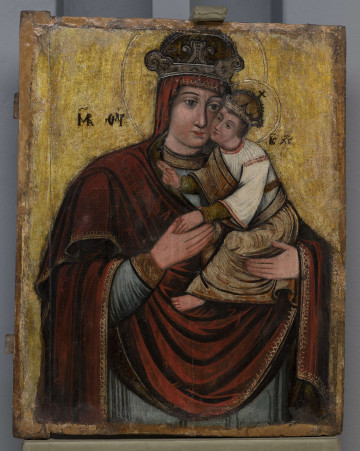
Eucharistic Christ
1801 — 1900
National Museum in Lublin
Part of the collection: Icons (17th–19th c.)
The image shows Christ as a vine branch – a vine shoot grows out of his side, and Jesus squeezes its grape into the chalice. Such an approach symbolises the eucharistic dimension of Christ’s mission and presents him as a life-giving source. It refers to the Gospel script: ‘I am the noble vine, and my Father is the gardener’ (Jn 15: 1). The composition is a distant echo of Nikodem Zubrzycki’s woodcut (adorning the title page of Służebnik, published in 1691 by the printing house of the Stauropigial Brotherhood in Lviv) or of its copy in the form of another icon or graphic. This woodcut became a model for many icons created in the first half of the 18th century and contributed to the popularisation of this theme in painting of the Eastern Church. On the back of the plank is the inscription in Cyrillic, ‘Thanks to the efforts and under the guidance of Reverend Łukasz Semenowicz’ and the date ‘1709’, which confirms the dating of the building at the beginning of the 18th century. The concept that the representation is based on a graphic copy rather than the original woodcut is suggested by a mirror image of the composition as compared to Zubrzycki’s graphics. Moreover, the change of the colours of Mary’s robes (in the tradition of icon painting, the Mother of God was depicted in a blue dress and a red maphorion – a shawl) may indicate an inspiration with monochrome graphics or a replication of the Western painting scheme (with a blue coat and a red dress). In the lower part of the representation, on the axis of the composition, there is an openwork double doors resembling the tsarist gate (an element of the iconostasis), decorated with a floral ornament with a grapevine motif and covered with gilding. They indicate the function of the object – it was the front wall of the Tabernacle. Therefore, it is not an ordinary icon, but an element of the church furnishings containing an iconographic programme emphasising the particular importance related to the place where the Eucharistic host is being stored.
Author / creator
Dimensions
cały obiekt: height: 76,5 cm, width: 76,5 cm
Object type
painting
Technique
tempera
Material
plank, tempera
Creation time / dating
Creation / finding place
Owner
The National Museum in Lublin
Identification number
Location / status

1801 — 1900
National Museum in Lublin

1601 — 1700
National Museum in Lublin

1701 — 1800
National Museum in Lublin
DISCOVER this TOPIC
National Museum in Szczecin
DISCOVER this PATH
Educational path